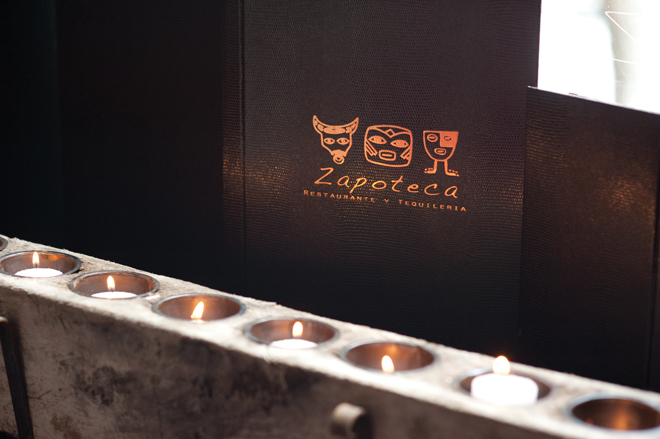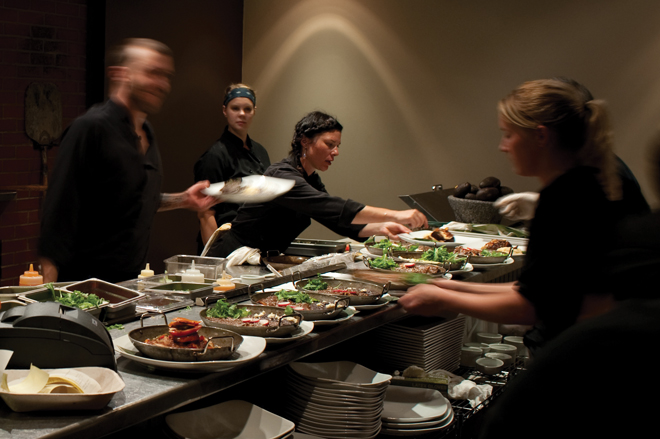Zapoteca
EAT FEATURE-October 2011
By Joe Ricchio
Photographs by C.A. Smith Photography
This contemporary Mexican eatery brings promising news for tequila lovers everywhere: they pour more than 75 different labels to complement their locally influenced, ever-changing menu. It sounds to me like weve got some drinking to do.
The Zapotec people are indigenous to Mexico. Most of their population is now concentrated in the state of Oaxaca, and their local economy is based primarily on corn, black beans, and squash. The tortilla is revered above all other foods, and cooking is still done painstakingly by hand, utilizing equipment and methods that date back hundreds of years.
In some restaurants that bill themselves as “authentic,” the food is often anything but. In stark contrast, an eighty-year-old Zapotecan woman huddled over a comal oven and making tortillas by hand would never dream of using the word “authentic.” To her, authenticity just is.
All of this being said, it makes perfect sense when Sergio Ramos, managing partner at Zapoteca, refers to their menu as “authentic enough.” He recognizes that the restaurant doesn’t serve the exact same food that his grandmother used to cook for him when he was growing up in Jalisco, Mexico, but the cuisine still pays homage to the old world while incorporating local Maine ingredients and modern flair.
Tom Bard opened Zapoteca with his wife, Shannon, in June of 2011, aiming to provide an experience unlike that of any other Mexican restaurant in Portland. After growing up in California, where Latin food is plentiful, Tom helped move his grandmother to Guadalajara. He continued to visit her several times each year and grew enamored with the foods of Mexico.
Tom began his restaurant career at the age of 15, washing dishes at a high-end Mexican eatery in California. After forty years in the business, his professional experiences have spanned everything from waiting tables in small taquerias to serving as regional vice president for one of America’s largest and most successful corporations.
While Shannon runs the kitchen, Tom oversees the front-of-house operations—yet on a recent visit I caught him aproned up and bogged down in the dish pit. He refers to himself as “old school,” and he loves working long hours and clearly views no task as beneath him.
While attending the Culinary Institute of America in San Antonio, Shannon specialized in Oaxacan cuisine. Her mentor’s mole recipe is on the Zapoteca menu, unchanged. “It has 25 ingredients and has been passed down for generations through her family. If it ain’t broke, don’t fix it!” Shannon says.
She also claims to “hate salads,” a bold statement that I find hard to believe after tasting the ensalada de avocado frita y maiz—leafy local greens topped with fire-roasted sweet corn, perfectly breaded fried avocado, and a buttermilk-jalapeno dressing.
“Growing up in Oklahoma, anytime you received a salad it was iceberg lettuce, always with the iceberg lettuce. This definitely ruined it for me. I wanted to create a dish for all of the other salad haters out there,” she jokes.
After searching for about a year, Tom and Shannon happened upon the building that formerly housed Una, a festively debauched but now-defunct nightclub that operated for about a decade in the Old Port of Portland. After Una closed its doors in 2009, the space was briefly occupied by Siano’s Brick Oven Pizza. When the restaurant moved on, the oven stayed. The addition of a large wooden bar, constructed from materials salvaged from old barns, gives the space a rustic feel. A collection of Zapotec masks, accumulated over several years, adorns the walls to, I assume, ward off bad spirits—and poor tippers.
Shannon’s firm belief that “nothing elevates the flavor of food like fire roasting” becomes evident upon tasting the queso fundido con champinones—bubbly melted cheese with mushrooms, grilled red onions, and dark beer that is served straight from the oven with freshly fried tortilla chips.
Zapoteca bills itself as a “tequileria,” and the heart and soul of its imaginative tequila creations is Tom’s longtime friend Sergio Ramos. They met each other while working at a restaurant in Boston 25 years ago, and they have worked together ever since. Tom recalls his first impressions of Sergio: “He was a hard worker with a bad attitude, and he loved to drink tequila.”
Sergio has pieced together an extremely impressive tequila selection that features more than ninety bottles, including many high-end offerings, such as Don Julio 1942. He has even worked with the state liquor board to bring producers into Maine that were previously unavailable. He continues to do so, attempting to register exclusive labels that fetch up to $600 a bottle. His response to brokers questioning his sanity: “What are they worried about? If I don’t sell it then I’m going to drink it myself!”
Although Zapoteca certainly has quantity, Sergio has kept the emphasis on quality, avoiding run-of-the-mill brands like Jose Cuervo Gold. “When customers complain that I don’t carry bottles like that, I often choose something and put a taste in front of them, explaining that if they don’t like it I’ll buy it,” Sergio continues. “And you know what? They usually end up having a second after they finish.”
Zapoteca serves all of their tequila accompanied by a shot of their delicious house-made sangrita, a traditional palate cleanser made with tomato juice, smoky peppers, and tomatillos. Although I despise tomato juice personally, I now find myself craving this beverage on a daily basis—that’s how good it is.
Tequila is always served at room temperature, since chilling tends to smother the lush flavors. Flights, served in threes and focusing on different producers—including Herradura, Diamante, and Corzo—are an ideal way to compare styles and tastes side by side (and to justify drinking more than you should).
I’ve found that plata tequila pairs up well with the salty tang of ceviche Veracruzano—white fish marinated in lime with tomato, jalapeno, avocado, and Manzanilla olives. On the other hand, a rich and smoky anejo is a better choice for the carnitas—pork braised in its own fat until meltingly tender and then crisped up on the outside and served with earthy black beans and salty queso fresco.
Margaritas are constructed using agave nectar instead of simple syrup, and fresh-squeezed lime juice. According to Tom, the restaurant juices an average of 1,400 limes a week, a figure that increases my respect for the bar staff in charge of this epic undertaking.
With so much emphasis on tequila and cocktails, it’s reassuring to see that the wine list is not an afterthought. Tom has done an excellent job covering all the essential bases, putting together a collection that emphasizes small and interesting wineries.
Although there are as many opinions as there are styles when it comes to outstanding Mexican cuisine, anyone would agree that Zapoteca’s creative menu and superlative tequila selection are a long overdue addition to Portland’s ever-growing dining scene.
And one more thing: make sure you get the flan.
505 Fore St. | Portland | 207.772.8242 | zapotecarestaurant.com






















